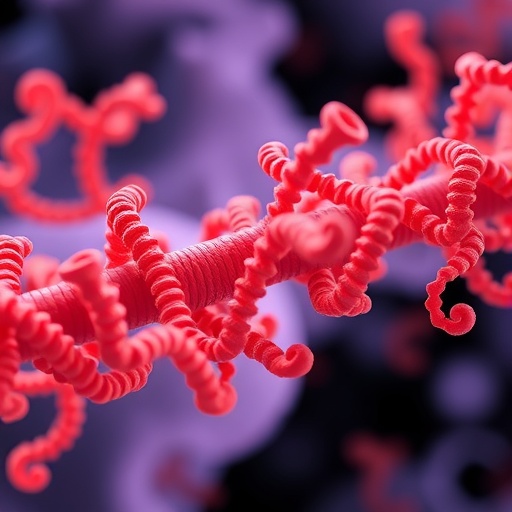In an era where the complexity of cellular signaling pathways continues to unravel, ankyrin repeat-containing (AR) proteins have emerged as pivotal modulators bridging structural motifs to functional outcomes within the nucleus. Recent groundbreaking research illuminates how these AR proteins intricately govern transcriptional and epigenetic landscapes, with profound implications for inflammation, immunity, and oncogenesis. Central among these networks is the NF-κB signaling cascade, a master regulator of immune homeostasis and inflammatory responses, whose activity is tightly modulated by its interactions with AR-containing proteins.
NF-κB transcription factors form dimers from five key subunits—RelA (p65), RelB, c-Rel, NF-κB1 (p50/p105), and NF-κB2 (p52/p100)—allowing functional versatility in gene regulation. The dynamic interplay between these subunits and AR proteins orchestrates the fine-tuning of downstream transcription, a process now known to be heavily influenced by the ankyrin repeat domains acting as versatile protein–protein interaction modules. This structural motif appears instrumental in mediating not only inhibitory control but also chromatin remodeling and transcriptional specificity.
The IκB family, long recognized for its inhibitory regulation of NF-κB, is itself a fertile ground of AR domain-containing proteins. These encompass precursor proteins like p100 (IκBδ) and p105 (IκBγ), classical cytoplasmic inhibitors—IκBα, IκBβ, and IκBε—and the more recently appreciated nuclear IκBs, including Bcl-3, IκBζ, IκBNS, and IκBη. Each harbors six to eight ankyrin repeats that directly engage NF-κB dimers, thereby orchestrating nuanced regulatory outcomes. Intriguingly, these interactions transcend mere sequestration, as nuclear IκBs participate actively in transcriptional complexes to either repress or promote gene expression.
Among nuclear IκBs, IκBζ forms a transcriptionally active complex with p50 and p52 NF-κB subunits on specific target genes such as Lcn2, employing a critical aspartate residue within its first ankyrin repeat for the interaction. The nuanced recognition of specific NF-κB subunits highlights the precision of AR-mediated binding, suggesting architectural adaptability encoded within these motifs. Bcl-3 further exemplifies the multifaceted nature of these interactions, stabilizing p50 homodimers on DNA and preventing their ubiquitination, thereby modulating inflammatory gene expression. Structural studies reveal that Bcl-3 extensively contacts ARs 1, 6, and 7 of p50, underscoring the spatial specificity inherent in AR domain engagements.
IκBη extends this paradigm, utilizing its eight ankyrin repeats to bind p50, a process integral to its nuclear localization and function. This emphasizes that ARs not only mediate protein–protein interactions but can also influence subcellular distribution, offering a dual regulatory axis in transcriptional control. Collectively, these insights redefine nuclear IκBs from passive inhibitors to active transcriptional co-regulators, intricately sculpting NF-κB-driven gene expression.
The ASPP family, encompassing ASPP1, ASPP2, and the inhibitory iASPP, further exemplify AR-domain-mediated regulation at the interface of apoptosis and inflammation. Characterized by their C-terminal proline-rich region, four ankyrin repeats, and SH3 domain, these proteins utilize their ANK-SH3 composite to engage the p65 subunit of NF-κB. Through these interactions, ASPP2 can interface with NF-κB pathways, integrating apoptotic control with inflammatory signaling, a nexus vital for cellular fate decisions in stress and disease contexts. The inhibitory iASPP likewise binds p65, indicating that modulation by AR proteins spans activation to suppression within NF-κB-driven transcription.
Intriguingly, the NF-κB family itself is autoregulatory through its ankyrin repeats. The ubiquitin ligase KPC1 targets the AR domain of NF-κB precursor p105, enhancing its ubiquitination and limiting proteasomal processing into p50. This regulatory mechanism influences the balance of NF-κB dimers and downstream gene expression, impacting tumor suppressor expression and immune cell recruitment. The capacity of AR domains within NF-κB proteins to attract ubiquitin ligases reflects a sophisticated self-modulatory feedback controlling signaling amplitude and duration.
Notably, the gene NRARP, itself a Notch target, encodes a protein comprising three ankyrin repeats that extend the NICD ankyrin repeat stack upon forming a tripartite complex with NICD1 and RBPJ. This extension acts as a negative feedback loop, tempering Notch signaling output and illustrating how AR domain architecture can shape transcription factor complex conformation and function. This mechanistic insight into NRARP’s role completes a feedback circuit integral for fine-tuning vascular development.
This emerging paradigm underscores ankyrin repeats as modular units of regulation transcending canonical structural roles. Their presence across diverse proteins—ranging from classical inhibitors like IκBs to oncoproteins like p28GANK, and signaling mediators like NICD and NRARP—demonstrates a conserved evolutionary strategy to exploit repeat motifs for dynamic protein interactions, subcellular localization, and transcriptional control. Such versatility grants AR-containing proteins the ability to govern multiple signaling pathways simultaneously, making them prime candidates for therapeutic targeting in inflammation, cancer, and developmental disorders.
Given the ubiquity and functional diversity of ankyrin repeats, future research will undoubtedly uncover novel AR-containing players and mechanisms in epigenetic and transcriptional regulation. Structural biology combined with systems-level analysis of AR-mediated interactomes promises to reveal comprehensive networks that govern cellular identity and response, providing unprecedented opportunities to manipulate these pathways in disease intervention. The exquisite specificity and adaptability of AR domains offer templates for designing small molecules or biologics that modulate protein–protein interactions currently deemed undruggable.
As our understanding expands, the convergent roles of ankyrin repeat proteins in both NF-κB and Notch signaling pathways underscore the integrative nature of cellular signaling hubs. They act not only as structural motifs but as finely tuned regulatory elements that determine the specificity, timing, and magnitude of transcriptional responses. This knowledge pivots ankyrin repeats from peripheral structural components to central regulatory nodes with broad impact on health and disease.
In summary, the intricate dance of ankyrin repeat-containing proteins in modulating transcription factors like NF-κB and NICD reveals a landscape of complex protein interaction networks vital for cellular regulation. Their modulation of gene expression networks implicates these AR modules as keystones in the balance between homeostasis and pathology. Unlocking their mechanistic secrets heralds a new chapter in molecular biology, where precise control over these repeat domains might pave the way for novel therapies across a spectrum of inflammatory, oncogenic, and developmental diseases.
—
Subject of Research: Ankyrin repeat-containing proteins and their roles in epigenetic and transcriptional regulation.
Article Title: The role of ankyrin repeat-containing proteins in epigenetic and transcriptional regulation.
Article References: Wu, M., Zhao, Y., Yang, J. et al. The role of ankyrin repeat-containing proteins in epigenetic and transcriptional regulation. Cell Death Discov. 11, 232 (2025). https://doi.org/10.1038/s41420-025-02519-4
Image Credits: AI Generated
DOI: https://doi.org/10.1038/s41420-025-02519-4
Tags: ankyrin repeat proteinscellular signaling pathwayschromatin remodeling processesepigenetic modulation in cellsimmune response regulationinflammation and immune homeostasisIκB family of proteinsNF-kB signaling pathwayoncogenesis and cancer biologyprotein-protein interactions in gene expressionstructural motifs in molecular biologytranscriptional regulation mechanisms





